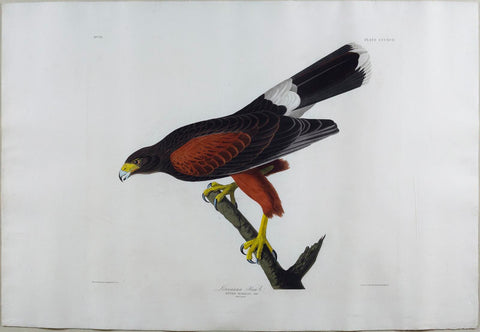
John James Audubon (1785-1851), Plate CCCLXXII Common Buzzard or Swainson’s Hawk
John James Audubon (1785-1851)
Plate CCCLXXII Common Buzzard or Swainson’s Hawk
from Birds of America
Aquatint engraving with original hand coloring
Engraved by Robert Havell (1793-1878)
Published: London, 1827-1838
Paper size: 39 1/2 x 26 1/2 in.
Framed size: 49 1/2 x 37 in.
Provenance: The Magnificent Sachsen-Meiningen Set of Audubon
From the magnificent Sachsen-Meiningen set of Audubons, which was originally owned by King William IV of England and was never bound and thus has full uncut margins and beautiful color.
The specimen from which the figure before you was taken, was shot by Mr. Townsend on a rock near the Columbia river, on which it had its nest. Unfortunately, however, he has not supplied me with any account of this species, and the only notice respecting its habits that I have seen, is that in the Fauna Boreali-Americana, by Dr. Richardson:--’The Common Buzzard arriving in the Fur Countries in the middle of April very soon afterwards begins to build its nest; and, having reared its young, departs about the end of September. It haunts the low alluvial points of land which stretch out under the high banks of a river; and may be observed sitting for a long time motionless on the bough of a tree, watching patiently for some small quadruped, bird, or reptile to pass within its reach. As soon as it espies its prey, it glides silently into the air, and, sweeping easily and rapidly down, seizes it in its claws. When disturbed, it makes a short circuit, and soon settles on another perch. It builds its nest on a tree, of short sticks, lining it sparingly with deer’s hair. The eggs, from three to five in number, are equal in size to those of the domestic fowl, and have a greenish-white colour, with a few large dark brown blotches at the thick end. It was seen by the Expedition as far north as the fifty-seventh parallel of latitude, and it most probably has a still higher range.’”
John James Audubon is without rival the most celebrated American natural history artist. Audubon devoted his life to realizing his dream of identifying and depicting the birds of North America, and his work has had profound cultural and historical significance. In the second decade of the 19th century, he set out to travel throughout the wilderness of the United States, drawing every notable species of native bird. His remarkable ambition and artistic talent culminated in the publication of the monumental Birds of America in 1827-38, a series of 435 aquatints that have only grown in fame since the time of their first appearance. This work established Audubon as an early American artist who could attract European attention, and for many, he personified New World culture and its emerging independent existence.
Audubon was born in Haiti, the illegitimate Creole son of a French sea merchant and a local chambermaid. He was raised in France until 1803, when his father sent him to the United States to avoid being drafted into the Napoleonic wars. There he started what proved to be a long run of unsuccessful schemes. He tried to run a lead mine in Pennsylvania. It folded. After marrying, he opened up a store in Louisville and it, too, went under. He started a steamboat line, and it led him into bankruptcy. By then he was 35 and, he admitted to his wife, a failure.
But throughout his life he nourished a passion for the study and illustration of bird life. At the time, marketing was not as unlikely an endeavor for Audubon as it might seem today. It was a respectable, if somewhat chancy, business, and natural history was a popular subject; in fact, Audubon faced considerable competition. He had little formal training in art and even less in ornithology, but what he lacked in experience he made up for in braggadocio. He pursued his birds with an unusual passion for accuracy and painterly beauty, a fervor caused as much by desperation as by scientific and aesthetic high-mindedness. For years he tracked his subjects to the known edges of the country; the journals he kept along the way are a literary achievement in themselves. By his death in 1851, he had completed 584 individual studies, 435 of which appeared in The Birds of America.
We Also Recommend





